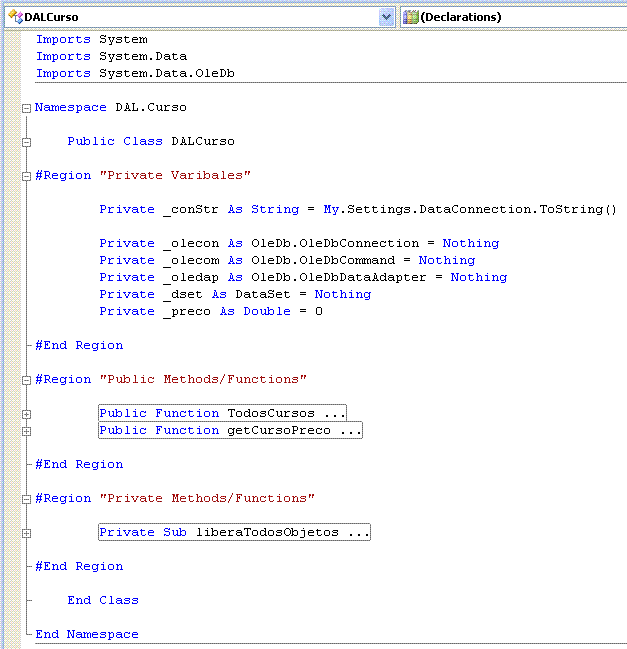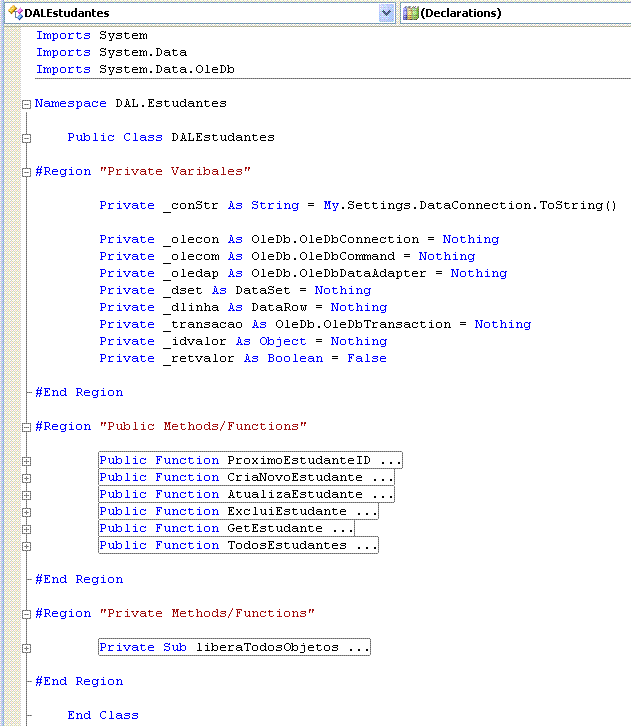![]() VB .NET - Criando uma
aplicação em camadas (de novo) III
VB .NET - Criando uma
aplicação em camadas (de novo) III
Continuando o artigo VB .NET - Criando uma aplicação em camadas (de novo) II vou definir o conteúdo das classes DALCurso e DALEstudantes que fazem parte da camada de acesso a dados que foi definida como um projeto distinto com o nome de DataAccessLayer.
Estas classes terão a responsabilidade de conhecer e acessar o sistema de persistência que neste exemplo esta sendo representando por um banco de dados do Microsoft Access. Neste contexto a classe DALCurso tem a especialidade de acessar os dados e realizar as operações pertinentes aos Cursos definido pela entidade Curso e representada pela tabela Cursos do banco de dados Matricula.mdb.
Definindo a classe DALCurso
A classe DALCurso possui a seguinte estrutura onde temos representados os imports, namespaces, variáveis e métodos públicos e privados:
 |
Com isso em mente vamos declarar no início do arquivo DALCurso.vb os imports usados:
Imports
SystemA seguir vamos declarar um namespace :
Namespace
DAL.CursoA seguir defina o nome da classe :
Public
Class DALCursoVamos as variáveis usadas para tratar os objetos de acesso a dados, no caso os objetos do provedor OleDb. Criamos dessa forma um objetos do tipo Connection, Command, Adapter e Dataset e o mais importante obtemos a string de conexão definida em My.Settings :
 |
Private _conStr As String = My.Settings.DataConnection.ToString()
Private _olecon As OleDb.OleDbConnection = Nothing
Private _olecom As OleDb.OleDbCommand = Nothing Private _oledap As OleDb.OleDbDataAdapter = Nothing Private _dset As DataSet = Nothing Private _preco As Double = 0Na classe DALCurso iremos definir dois métodos que acessam os dados dos cursos:
Estes métodos são chamados pela classe BLLCurso da camada de negócio - BusinessLogicLayer.
1- Método TodosCursos()
|
Public
Function TodosCursos()
As
DataSet _dset = Nothing Try_olecon = New OleDb.OleDbConnection(_conStr)_olecon.Open() _olecom = New OleDb.OleDbCommand()With _olecom .Connection = _olecon .CommandType = CommandType.Text .CommandText = "SELECT cursoID,cursoNome " & _"FROM Cursos ORDER BY cursoID" End With
_dset = New DataSet()_oledap.Fill(_dset) Catch ex As Exception_dset = Nothing Throw ex FinallyliberaTodosObjetos() End TryReturn _dset End Function |
2- Método getCursoPreco() - passa como parâmetro o código do curso (CursoID)
|
Public
Function getCursoPreco(ByVal
CursoID As
Integer)
As
Double
_preco = 0 Try _olecon = New OleDb.OleDbConnection(_conStr)_olecon.Open() _olecom = New OleDb.OleDbCommand()
With _olecom .Connection = _olecon .CommandType = CommandType.Text .CommandText = "SELECT cursoPreco FROM Cursos WHERE cursoID =@CursoID" .Parameters.Add( "@CursoID", OleDbType.Integer).Value = CursoID_preco = CType(.ExecuteScalar(), Double)End With
_olecom.Parameters.Clear() Catch ex As Exception_preco = 0 Throw ex FinallyliberaTodosObjetos() End TryReturn _preco End Function |
Temos também um método de suporte que libera os objetos usados, liberaTodosObjetos() cujo código é:
|
Private
Sub liberaTodosObjetos() If _oledap IsNot Nothing Then _oledap.Dispose() _oledap = Nothing End IfIf _olecom IsNot Nothing Then _olecom.Cancel() _olecom.Dispose() _olecom = Nothing End IfIf _olecon IsNot Nothing Then If _olecon.State = ConnectionState.Open Then _olecon.Close() End If _olecon.Dispose() _olecon = Nothing End If End Sub |
Definindo a classe DALEstudantes
A classe DALEstudantes possui a seguinte estrutura onde temos representados os imports, namespaces, variáveis e métodos públicos e privados:
 |
Começamos com a declaração no início do arquivo DALEstudantes.vb, os imports usados:
Imports
SystemA seguir vamos declarar um namespace :
Namespace
DAL.EstudantesA seguir defina o nome da classe :
Public
Class DALEstudantesA seguir definimos as variáveis e objetos usados na classe:
Private _conStr As String = My.Settings.DataConnection.ToString()Private _olecon As OleDb.OleDbConnection = Nothing
Private _olecom As OleDb.OleDbCommand = Nothing Private _oledap As OleDb.OleDbDataAdapter = Nothing Private _dset As DataSet = Nothing Private _dlinha As DataRow = Nothing Private _transacao As OleDb.OleDbTransaction = Nothing Private _idvalor As Object = Nothing Private _retvalor As Boolean = FalseA classe DALEstudantes terá os seguintes métodos responsáveis pelo acesso a dados dos estudantes:
Esses métodos são chamados pela classe BLLEstudante da camada de negócio - BusinessLogicLayer.
|
Public
Function
ProximoEstudanteID() As
String
_idvalor = Nothing Try_olecon = New OleDb.OleDbConnection(_conStr)_olecon.Open() _olecom = New OleDb.OleDbCommand() With _olecom.Connection = _olecon .CommandType = CommandType.Text .CommandText = "SELECT MAX(EstudanteID) AS EstudanteID FROM Estudantes"_idvalor = .ExecuteScalar() End With 'Formato do Numero do Estudante. Ex:S0001, S0002 ' ---- SXXXX If _idvalor Is Nothing Or _idvalor.Equals(System.DBNull.Value) Then_idvalor = "S0001" Else Dim valor As Integer = 0valor = _idvalor.ToString().Substring(1, (_idvalor.ToString().Length - 1)) + 1 If valor >= 0 And valor <= 9 Then _idvalor = "S000" & valor.ToString() If valor >= 10 And valor <= 99 Then _idvalor = "S00" & valor.ToString() If valor >= 100 And valor <= 999 Then _idvalor = "S0" & valor.ToString() If valor >= 1000 And valor <= 9999 Then _idvalor = "S" & valor.ToString() End If Catch ex As Exception_idvalor = Nothing Throw ex FinallyliberaTodosObjetos() End Try Return _idvalor.ToString() End Function
|
|
ProximoEstudanteID |
|
Public Function CriaNovoEstudante(ByVal EstudanteID As String, ByVal CursoID As Integer, ByVal EstudanteNome As String, _ ByVal EstudanteEndereco As String, ByVal Telefone As String, _ ByVal Idade As Integer, ByVal EstaPago As Boolean) As Boolean_retvalor = False Try_olecon = New OleDb.OleDbConnection(_conStr)_olecon.Open() _transacao = _olecon.BeginTransaction(IsolationLevel.ReadCommitted) _olecom = New OleDb.OleDbCommand() With _olecom.Connection = _olecon .CommandType = CommandType.Text .CommandText = "INSERT INTO Estudantes " & _ "(EstudanteID,cursoID,estudanteNome,estudanteEndereco,estudanteTelefone,estudanteIdade,estudantePago,estudanteDataRegistro) VALUES " & _ "(@EstudanteID,@cursoID,@estudanteNome,@estudanteEndereco,@estudanteTelefone,@estudanteIdade,@estudantePago,@estudanteDataRegistro)".Parameters.Add( "@EstudanteID", OleDbType.VarChar, 5).Value = EstudanteID.Trim().Parameters.Add( "@cursoID", OleDbType.Integer).Value = CursoID.Parameters.Add( "@estudanteNome", OleDbType.VarChar, 100).Value = EstudanteNome.Trim().Parameters.Add( "@estudanteEndereco", OleDbType.VarChar, 100).Value = EstudanteEndereco.Trim().Parameters.Add( "@estudanteTelefone", OleDbType.VarChar, 10).Value = Telefone.Trim().Parameters.Add( "@estudanteIdade", OleDbType.Integer).Value = Idade.Parameters.Add( "@estudantePago", OleDbType.Boolean).Value = EstaPago.Parameters.Add( "@estudanteDataRegistro", OleDbType.Date).Value = Now.ToString("dd/MMM/yyyy").Transaction = _transacao .ExecuteNonQuery() .Parameters.Clear() End With_transacao.Commit() _retvalor = True Catch ex As Exception_transacao.Rollback() Throw ex FinallyliberaTodosObjetos() End Try Return _retvalor End Function
|
|
CriaNovoEstudante() |
|
Public
Function
AtualizaEstudante(ByVal
EstudanteID As
String,
ByVal CursoID
As
Integer,
ByVal EstudanteNome
As
String,
_
ByVal EstudanteEndereco
As
String,
ByVal Telefone
As
String,
_
ByVal Idade
As
Integer,
ByVal EstaPago
As
Boolean)
As
Boolean
_retvalor = False Try_olecon = New OleDb.OleDbConnection(_conStr)_olecon.Open() _transacao = _olecon.BeginTransaction(IsolationLevel.ReadCommitted) _olecom = New OleDb.OleDbCommand() With _olecom.Connection = _olecon .CommandType = CommandType.Text .CommandText = "UPDATE Estudantes " & _ "SET cursoID =@cursoID," & _ "estudanteNome =@estudanteNome," & _ "estudanteEndereco =@estudanteEndereco," & _ "estudanteTelefone =@estudanteTelefone," & _ "estudanteIdade = @estudanteIdade," & _ "estudantePago = @estudantePago " & _ "WHERE EstudanteID=@EstudanteID".Parameters.Add( "@cursoID", OleDbType.Integer).Value = CursoID.Parameters.Add( "@estudanteNome", OleDbType.VarChar, 100).Value = EstudanteNome.Trim().Parameters.Add( "@estudanteEndereco", OleDbType.VarChar, 100).Value = EstudanteEndereco.Trim().Parameters.Add( "@estudanteTelefone", OleDbType.VarChar, 10).Value = Telefone.Trim().Parameters.Add( "@estudanteIdade", OleDbType.Integer).Value = Idade.Parameters.Add( "@estudantePago", OleDbType.Boolean).Value = EstaPago.Parameters.Add( "@EstudanteID", OleDbType.VarChar, 5).Value = EstudanteID.Trim().Transaction = _transacao .ExecuteNonQuery() .Parameters.Clear() End With_transacao.Commit() _retvalor = True Catch ex As Exception_transacao.Rollback() Throw ex FinallyliberaTodosObjetos() End Try Return _retvalor End Function
|
|
AtualizaEstudante |
|
Public Function ExcluiEstudante(ByVal EstudanteID As String) As Boolean_retvalor = False Try_olecon = New OleDb.OleDbConnection(_conStr)_olecon.Open() _transacao = _olecon.BeginTransaction(IsolationLevel.ReadCommitted) _olecom = New OleDb.OleDbCommand() With _olecom.Connection = _olecon .CommandType = CommandType.Text .CommandText = "DELETE FROM Estudantes WHERE EstudanteID=@EstudanteID".Parameters.Add( "@EstudanteID", OleDbType.VarChar, 5).Value = EstudanteID.Trim().Transaction = _transacao .ExecuteNonQuery() .Parameters.Clear() End With_transacao.Commit() _retvalor = True Catch ex As Exception_transacao.Rollback() Throw ex FinallyliberaTodosObjetos() End Try Return _retvalor End Function
|
|
ExcluiEstudante() |
|
Public
Function GetEstudante(ByVal
EstudanteID As
String)
As
DataRow
_dlinha = Nothing Try_olecon = New OleDb.OleDbConnection(_conStr)_olecon.Open() _olecom = New OleDb.OleDbCommand() With _olecom.Connection = _olecon .CommandType = CommandType.Text .CommandText = "SELECT Estudantes.EstudanteID, Estudantes.estudanteNome, Estudantes.estudanteEndereco, " & _ "Estudantes.estudanteTelefone, Estudantes.estudanteIdade, Estudantes.cursoID, " & _"Cursos.cursoPreco, Estudantes.estudantePago " & _ "FROM Cursos INNER JOIN Estudantes ON Cursos.cursoID = Estudantes.cursoID " & _ "WHERE Estudantes.EstudanteID =@EstudanteID"
.Parameters.Add( "@EstudanteID", OleDbType.VarChar, 5).Value = EstudanteID.Trim() End With_oledap = New OleDb.OleDbDataAdapter(_olecom)_dset = New DataSet()_oledap.Fill(_dset) If _dset.Tables(0).Rows.Count > 0 Then_dlinha = _dset.Tables(0).Rows(0) Else_dlinha = Nothing End If_olecom.Parameters.Clear() Catch ex As Exception_dlinha = Nothing Throw ex FinallyliberaTodosObjetos() End Try Return _dlinha End Function
|
|
GetEstudante() |
|
Public
Function
TodosEstudantes() As
DataSet
_dset = Nothing Try_olecon = New OleDb.OleDbConnection(_conStr)_olecon.Open() _olecom = New OleDb.OleDbCommand() With _olecom.Connection = _olecon .CommandType = CommandType.Text .CommandText = "SELECT EstudanteID,estudanteNome,estudanteTelefone " & _"FROM Estudantes ORDER BY estudanteNome" End With _oledap = New OleDb.OleDbDataAdapter(_olecom)_dset = New DataSet()_oledap.Fill(_dset) Catch ex As Exception_dset = Nothing Throw ex FinallyliberaTodosObjetos() End Try Return _dset End Function
|
|
TodosEstudantes() |
Note que as classes DALCurso e DALEstudante possuem métodos que conhecem apenas como acessar e retornar os dados e nelas não há lógica de negócio.
Temos também um método de suporte que libera os objetos usados, liberaTodosObjetos() cujo código é:
|
Private
Sub
liberaTodosObjetos() If _transacao IsNot Nothing Then _transacao.Dispose() _transacao = Nothing End IfIf _oledap IsNot Nothing Then _oledap.Dispose() _oledap = Nothing End IfIf _olecom IsNot Nothing Then _olecom.Cancel() _olecom.Dispose() _olecom = Nothing End IfIf _olecon IsNot Nothing Then If _olecon.State = ConnectionState.Open Then _olecon.Close() End If _olecon.Dispose() _olecon = Nothing End If End Sub |
Com isso encerramos as definições das classes da camada de acesso dados DataAccesLayer. Iremos definir agora a camada de interface representada pelo projeto EstudanteMatricula criado na primeira parte deste artigo.
Neste exemplo nossa camada de apresentação será uma aplicação Windows Forms mas poderíamos ter usando um projeto web ou mobile. Repetindo a definição para cada uma das camadas temos:
Veja a continuação deste artigo em : VB .NET - Criando uma aplicação em camadas (de novo) IV
|
Veja os
Destaques e novidades do SUPER DVD Visual Basic
(sempre atualizado) : clique e confira !
Quer migrar para o VB .NET ?
Quer aprender C# ??
Quer aprender os conceitos da Programação Orientada a objetos ? Quer aprender o gerar relatórios com o ReportViewer no VS 2013 ? |
Gostou ?
![]() Compartilhe no Facebook
Compartilhe no Facebook
![]() Compartilhe no Twitter
Compartilhe no Twitter
Referências:
José Carlos Macoratti